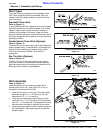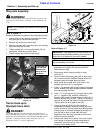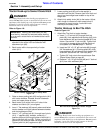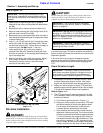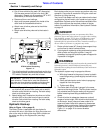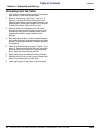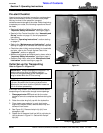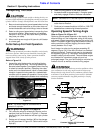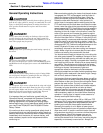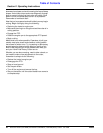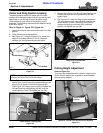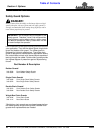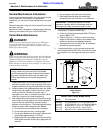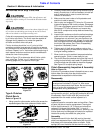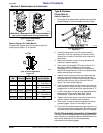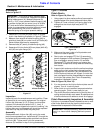
21
Section 2: Operating Instructions
8/28/08
RC5010 & RC6010 (540 RPM) and RCM5010 & RCM6010 (1000 RPM) Rotary Cutters 318-128M
Land Pride
Table of Contents
General Operating Instructions
!
CAUTION!
To prevent personal injury caused by thrown objects, the use of
front & rear safety guards is strongly recommended! To avoid
injury or death from entanglement in rotating drivelines, the
drive gearbox shields must be in place and secure when
operating.
!
DANGER!
Rotary cutters have the ability to discharge objects at high
speeds; therefore, the use of front & rear safety guards are
strongly recommended when cutting along highways or in an
area where people may be present.
!
CAUTION!
Damage may occur if exceeding the rated cutting capacity of
the cutter!
!
CAUTION!
Do not over speed PTO or machine damage may result.
RC series are designed for a tractor with 540 RPM rear PTO
and RCM series are designed for a tractor with 1000 RPM rear
PTO.
!
DANGER!
Do not lift deck to use cutting blades as a fan. Cutting blades
are not properly designed or guarded for this use. Using the
deck as a fan can result in injury and/or death.
!
DANGER!
Do not operate 10 ft. cutters without both the wing and weight
box attached to the center deck. Removing the wing or weight
box will expose blades and increase risk of cutter overturning.
Removing both will expose blades on both sides. Exposed
blades can result in serious injury and/or death.
It is important that you familiarize yourself with the
Operator’s Manual, completed the Operators Checklist,
properly attached the cutter to your tractor, made
leveling adjustments, and preset your cutting height
before beginning a running operational safety check on
your Land Pride RC(M)5010 and RC(M)6010 Series
Rotary Cutters.
It’s now time to do a running operational safety check. It
is important that at any time during this safety check you
detect a malfunction in either the cutter or tractor that you
immediately shut the tractor off, remove the key, and
make necessary repairs and/or adjustments before
continuing on.
Make sure before starting the tractor that the park brake
is engaged, the PTO is disengaged, and the cutter is
resting on the ground with the wing down. Start the
tractor and set the engine throttle speed at a low idle.
Raise the cutter with the tractor’s rear hydraulic lift
control lever to transport position making sure that the
PTO shaft does not bind and does not contact the cutter
frame. Lower the cutter to the ground and at a low engine
speed engage the PTO. If everything is running smoothly
at a low idle, slowly raise the cutter to transport height
checking for bind or chatter in the driveline. Lower the
cutter to the ground and increase the tractor’s engine
rpm until it reaches the cutter’s full PTO operating speed
which will be either 540 or 1000rpm. If everything is still
running smoothly, once more raise the cutter to transport
height to check for driveline bind or chatter. Lower the
cutter to the ground, return the engine to a low idle, and
disengage the PTO. Position the adjustable stops on the
tractor’s hydraulic lift lever so the cutter can be
consistently returned to the same cutting and transport
height. Make a tight turn to ensure that the rear tractor
tires are not coming into contact with the deck.
You should now be ready to transport to your cutting site
at a safe ground speed. On roadways, transport in such
a manner that faster moving vehicles can easily see you
and pass you safely. Reduce your speed when traveling
over rough and hilly terrain. Avoid quick or sharp steering
corrections. Take extra care to insure that the mower
doesn’t come into contact with obstacles such as trees,
buildings or fences. Use accessory lights and
appropriate reflective devices to provide adequate
warning to pedestrians and other vehicle operators when
traveling on public roads and in the dark of night. Comply
with all local, state and federal laws.
It is important that you inspect the area where you will be
cutting and clear it of safety hazards and foreign objects
either before or after you arrive at the cutting site. Never
assume the area is clear. Cut only in areas you are
familiar with and are free of debris and unseen objects.
Extremely tall grass should be cut twice to detect
potential hazards. In the event you do strike an object
stop the cutter and tractor immediately to inspect and
make necessary repairs to the cutter before resuming
operation. It really pays to inspect a new area and to
develop a safe plan before cutting.
You will need to maintain either 540 or 1000 rpm PTO
speed and 2 to 5 mph ground speed to produce a clean
cut. Make a tractor gear and range selection that will
enable you to maintain these speed combinations.
Generally the quality of cut is better at lower ground
speeds. Dense ground cover will create the need to slow
down even more. In certain conditions tractor tires will
roll grass down resulting in an uneven cut when the grass
fails to rebound. Should this happen you may try
reversing the direction of cut and/or double cut to
achieve the desired finish. Avoid very low cutting heights
especially on extremely uneven terrain. Always cut



